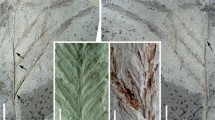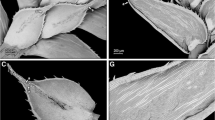Abstract
Cryptokerpia sarlaccophora gen. et sp. nov., an enigmatic type of gymnosperm leaf, is described based on dispersed cuticles retrieved from bulk-macerated samples of the Umm Irna Formation (Upper Permian) of the Dead Sea Region, Jordan. The most prominent diagnostic feature of the new genus is that stomatal pores are sunken deep into the epidermis at the bottom of multi-cellular stomatal crypts that are lined with multiple tiers of papillae. Vaguely similar ‘stomatal tubes’ are known from several plant groups (e.g., conifers, Bennettitales, Proteaceae, noeggerathiopsids), but are readily distinguished by their epidermal features and gross morphology. The Umm Irna Formation provides a unique window into rarely preserved dry-standing elements and demonstrates that, when these groups are preserved, they still hold great potential for future research.



Similar content being viewed by others
References
Abu Hamad, A., H. Kerp, B. Vörding, and K. Bandel. 2008. A late Permian flora with Dicroidium from the Dead Sea region, Jordan. Review of Palaeobotany and Palynology 149: 85–130. https://doi.org/10.1016/j.revpalbo.2007.10.006.
Abu Hamad, A., P. Blomenkemper, B. Bomfleur, and H. Kerp. 2017. Dicroidium bandelii sp. nov. (corystospermalean foliage) from the Permian of Jordan. PalZ 91(4): 391–400.
Abu Hamad, A. M. B. 2004. Palaeobotany and Palynostratigraphy of the Permo–Triassic in Jordan. PhD Thesis, University Hamburg. http://www.sub.uni-hamburg.de/opus/volltexte/2005/2309/pdf/dissertation.pdf. Accessed 5 June 2019.
Archangelsky, S., and T.N. Taylor. 1986. Ultrastructural studies of fossil plant cuticles. II. Tarphyderma gen. n., A Cretaceous Conifer from Argentina. American Journal of Botany 73: 1577–1587. https://doi.org/10.2307/2443925.
Balme, B.E. 1995. Fossil in situ spores and pollen grains: an annotated catalogue. Review of Palaeobotany and Palynology 87: 81–323. https://doi.org/10.1016/0034-6667(95)93235-X.
Bandel, K., and A. M. B. Abu Hamad. 2013. Permian and Triassic Strata of Jordan. In The Triassic System, eds. L.H. Tanner, J.A. Spielmann, and S.G. Lucas. New Mexico Museum of Natural History and Science. Bulletin 61: 31–41.
Bandel, K., and H. Khoury. 1981. Lithostratigraphy of the Triassic in Jordan. Facies 4: 1–26. https://doi.org/10.1007/BF02536584.
Berthelin, M., J. Broutin, D. Vaslet, Y.-M. Le Nindre, and M. Halawani. 2006. Mixed late Permian-floras and related palaeoenvironments in the Khuff Formation of central Saudi Arabia. GeoArabia 11: 65–86.
Berthelin, M., J. Broutin, H. Kerp, S. Crasquin-Soleau, J.P. Platel, and J. Roger. 2003. The Oman Gharif mixed paleoflora: a useful tool for testing Permian Pangea reconstructions. Palaeogeography, Palaeoclimatology, Palaeoecology 196: 85–98. https://doi.org/10.1016/S0031-0182(03)00314-6.
Blomenkemper, P., H. Kerp, A. Abu Hamad, W.A. DiMichele, and B. Bomfleur. 2018. A hidden cradle of plant evolution in Permian tropical lowlands. Science 362: 1414–1416. https://doi.org/10.1126/science.aau4061.
Bomfleur, B., C. Pott, and H. Kerp. 2011. Plant assemblages from the (Lower Jurassic), north Victoria Land, Transantarctic Mountains. Antarctic Science 23(2): 188–208.
Brodribb, T., and R.S. Hill. 1997. Imbricacy and stomatal wax plugs reduce maximum leaf conductance in southern hemisphere conifers. Australian Journal of Botany 45: 657–668. https://doi.org/10.1071/BT96060.
Brodribb, T., and R.S. Hill. 1998. The photosynthetic drought physiology of a diverse group of southern hemisphere conifer species is correlated with minimum seasonal rainfall. Functional Ecology 12: 465–471. https://doi.org/10.1046/j.1365-2435.1998.00213.x.
Carpenter, R.J., S. Mcloughlin, R.S. Hill, K.J. McNamara, and G.J. Jordan. 2014. Early evidence of xeromorphy in angiosperms: Stomatal encryption in a new Eocene species of Banksia (Proteaceae) from Western Australia. American Journal of Botany 101: 1486–1497. https://doi.org/10.3732/ajb.1400191.
DiMichele, W.A., and R.W. Hook. 1992. Paleozoic terrestrial ecosystems. In Terrestrial ecosystems through time, ed. A.K. Behrensmeyer, 206–325. Chicago, IL: University of Chicago Press.
DiMichele, W.A., S.H. Mamay, D.S. Chaney, R.W. Hook, and W.J. Nelson. 2001. An Early Permian flora with Late Permian and Mesozoic affinities from north-central Texas. Journal of Paleontology 75(2): 449–460.
Elicki, O., and G. Geyer. 2013. The Cambrian trilobites of Jordan—taxonomy, systematic and stratigraphic significance. Acta Geologica Polonica 63: 1–56.
Gomez, B., T.A.M. Ewin, and V. Daviero-Gomez. 2012. The conifer Glenrosa falcata sp. nov. from the Lower Cretaceous of Spain and its palaeoecology. Review of Palaeobotany and Palynology 172: 21–32. https://doi.org/10.1016/j.revpalbo.2012.01.009.
Gothan, W. 1954. Geobotanische Provinzen im Karbon und Perm. Forschungen und Fortschritte 28: 38–40.
Hassiotou, F., J.R. Evans, M. Ludwig, and E.J. Veneklaas. 2009. Stomatal crypts may facilitate diffusion of CO2 to adaxial mesophyll cells in thick sclerophylls. Plant, Cell and Environment 32: 1596–1611. https://doi.org/10.1111/j.1365-3040.2009.02024.x.
Haworth, M., and J. McElwain. 2008. Hot, dry, wet, cold or toxic? Revisiting the ecological significance of leaf and cuticular micromorphology. Palaeogeography, Palaeoclimatology, Palaeoecology 262: 79–90. https://doi.org/10.1016/j.palaeo.2008.02.009.
Hill, R.S. 1998. Fossil evidence for the onset of xeromorphy and scleromorphy in Australian Proteaceae. Australian Systematic Botany 11: 391–400. https://doi.org/10.1071/SB97016.
Jordan, J.J., P.H. Weston, R.J. Carpenter, R.A. Dillon, and T.J. Brodribb. 2008. The evolutionary relations of sunken, covered, and encrypted stomata to dry habitats in Proteaceae. American Journal of Botany 95: 521–530.
Kerp, H. 1990. The study of fossil gymnosperms by means of cuticular analysis. Palaios 5: 548–569. https://doi.org/10.2307/3514861.
Kerp, H., A. Abu Hamad, B. Vörding, and K. Bandel. 2006. Typical Triassic Gondwanan floral elements in the Upper Permian of the paleotropics. Geology 34(4): 265–268.
Kolodner, K., D. Avigad, M. McWilliams, J.L. Wooden, T. Weissbrod, and S. Feinstein. 2006. Provenance of north Gondwana Cambrian-Ordovician sandstone: U-Pb SHRIMP dating of detrital zircons from Israel and Jordan. Geological Magazine 143: 367–391. https://doi.org/10.1017/S0016756805001640.
Krings, M., and H. Kerp. 1997. An improved method for obtaining large pteridosperm cuticles. Review of Palaeobotany and Palynology 96: 453–456. https://doi.org/10.1016/S0034-6667(96)00059-0.
Makhlouf, I.M., B.R. Turner, and A.M. Abed. 1991. Depositional Facies and Environments in the Permian Umm Irna Formation, Dead-Sea Area, Jordan. Sedimentary Geology 73: 117–139. https://doi.org/10.1016/0037-0738(91)90026-A.
Mcloughlin, S., and A.N. Drinnan. 1996. Anatomically preserved Permian Noeggerathiopsis leaves from east Antarctica. Review of Palaeobotany and Palynology 92: 207–227. https://doi.org/10.1016/0034-6667(96)00134-0.
Meyen, S.V., and H.G. Smoller. 1986. The genus Mostotchkia chachlov (upper palaeozoic of angaraland) and its bearing on the characteristics of the order dicranophyllales (pinopsida). Review of Palaeobotany and Palynology 47: 205–223. https://doi.org/10.1016/0034-6667(86)90037-0.
Mustafa, H. 2003. A late Permian Cathaysian flora from the Dead Sea Area, Jordan. Neues Jahrbuch für Geologie und Paläontologie, Monatshefte 2003: 35–49.
Pott, C. 2013. Ctenophyllum—a junior synonym of Pterophyllum (Bennettitales: Williamsoniaceae). Neues Jahrbuch für Geologie und Paläontologie, Abhandlungen 269(3): 271–283. https://doi.org/10.1127/0077-7749/2013/0350.
Powell, J.H., M.H. Stephenson, A. Nicora, R. Rettori, L.M. Borlenghi, and M.C. Perri. 2016. The Permian–Triassic Boundary, Dead Sea, Jordan: Transitional Alluvial to Marine Depositional Sequences and Biostratigraphy. Rivista Italiana di Paleontologia e Stratigrafia 122: 23–39. https://doi.org/10.13130/2039-4942/7671.
Raven, P.H., R.F. Evert, and S.E. Eichhorn. 2005. Biology of plants, 7th ed. New York: Palgrave Macmillan.
Roth-Nebelsick, A. 2007. Computer-based Studies of Diffusion through Stomata of Different Architecture. Annals of Botany 100: 23–32. https://doi.org/10.1093/aob/mcm075.
Roth-Nebelsick, A., F. Hassiotou, and E.J. Veneklaas. 2009. Stomatal Crypts Have Small Effects on Transpiration: A Numerical Model Analysis. Plant Physiology 151: 2018–2027. https://doi.org/10.1104/pp.109.146969.
Scholze, F., A. Abu Hamad, J.W. Schneider, V.K. Golubev, A.G. Sennikov, S. Voigt, and D. Uhl. 2017. An enigmatic “conchostracan” fauna in the Eastern Dead Sea region of Jordan: First records of Rossolimnadiopsis Novozhilov from the Early Triassic Ma’in Formation. Palaeogeography, Palaeoclimatology, Palaeoecology 466: 314–325. https://doi.org/10.1016/j.palaeo.2016.11.047.
Srinivasan, V. 1992. Two new species of the conifer Glenrosa from the Lower Cretaceous of North America. Review of Palaeobotany and Palynology 72: 245–255.
Stephenson, M.H. 2015. Range of morphology in monolete spores from the uppermost Permian Umm Irna Formation of Jordan. Permophiles 61: 17–19.
Stephenson, M.H., and J.H. Powell. 2013. Palynology and alluvial architecture in the Permian Umm Irna Formation, Dead Sea, Jordan. GeoArabia 18: 17–60.
Stephenson, M.H., and J.H. Powell. 2014. Selected spores and pollen from the Permian Umm Irna Formation, Jordan, and their stratigraphic utility in the Middle East and North Africa. Rivista Italiana di Paleontologia e Stratigrafia 120: 145–156.
Thévenard, F., B. Gomz, and V. Daviero-Gomez. 2005. Xeromorphic adaptations of some Mesozoic gymnosperms. A review with palaeoclimatological implications. Comptes Rendus Palevol 4: 67–77.
Wagner, R. H. 1962. On a mixed Cathaysia and Gondwana flora from SE Anatolia (Turkey). In Compte Rendu du IVe Congrès pour l’Avancement des Études de Stratigraphie et de Géologie du Carbonifère (Heerlen) 3: 745–752. Maestricht: van Aelst.
Watson, J., and H.L. Fisher. 1984. A new conifer genus from the Lower Cretaceous Glen Rose Formation, Texas. Palaeontology 27: 719–727.
Watson, J., H.L. Fisher, and N.A. Hall. 1987. A new species of Brachyphyllum from the English Wealden and its probable female cone. Review of Palaeobotany and Palynology 51: 169–187. https://doi.org/10.1016/0034-6667(87)90028-5.
Wnuk, C. 1996. The development of floristic provinciality during the Middle and Late Paleozoic. Review of Palaeobotany and Palynology 90: 5–40. https://doi.org/10.1016/0034-6667(95)00025-9.
Ziegler, A.M., H.L. Hulver, and D.B. Rowley. 1997. Permian world topography and climate. In Late glacial and postglacial environmental changes Quaternary, Carboniferous-Permian and Proterozoic, ed. I.P. Martini, 111–146. New York: Oxford University Press.
Acknowledgments
We wish to thank Jörg Schneider and Frank Scholze (Freiberg), Sebastian Voigt (Thallichtenberg), Nidal S. and Haatem S. Badandi (Irbid, Jordan), and especially our good friend Hans for most enjoyable and successful field work. We appreciate the helpful comments and suggestions by Heidi Anderson-Holmes (Johannesburg, R.S.A.) and Brian Axsmith (Mobile, AL, U.S.A.) on an earlier version of the manuscript. Technical and financial support by the University of Jordan and by the German Science Foundation (DFG grants KE584/20-1 to Hans Kerp and BO3131/1-1 to BB) is gratefully acknowledged. Abdalla Abu-Hamad wishes to thank the German Science Foundation for the financial support during his stays in Germany (DFG grants BA675/26-1-3 to Klaus Bandel and KE584/20-1 to Hans Kerp). This manuscript is a contribution to the Emmy Noether Research Programme “Latitudinal Patterns in Plant Evolution”.
Author information
Authors and Affiliations
Corresponding author
Additional information
Handling Editor: Mike Reich.
Rights and permissions
About this article
Cite this article
Blomenkemper, P., Abu Hamad, A. & Bomfleur, B. Cryptokerpia sarlaccophora gen. et sp. nov., an enigmatic plant fossil from the Late Permian Umm Irna Formation of Jordan. PalZ 93, 479–485 (2019). https://doi.org/10.1007/s12542-019-00466-x
Received:
Accepted:
Published:
Issue Date:
DOI: https://doi.org/10.1007/s12542-019-00466-x




